Exploring the World in a Ford GPA SEEP
Authored by David Eilers from eWillys
As part of the original 1940 specifications for the jeep, the army included a desire for the vehicle to have 'Amphibian characteristics'. This capability was dropped during the development phase. However, in 1941, once jeep prototypes had been ordered, the military revisited the need for a jeep-like amphibious vehicle.
According to Jim Allen, Sparkman & Stephens Yacht Design was tasked with creating a plan for an amphibious jeep. In late 1941 Sparkman & Stephens provided the finished plans to the Marmon-Herrington Company and the Ford Motor Company. Marmon-Herrington constructed their version of a sea-going jeep based on three Willys MAs provided to them, while Ford constructed one based on the Ford GP prototype. During spring 1942 tests, the Ford sea-going prototype jeep out-performed the Marmon-Herrington vehicle and won the contract. Thus, Ford won the contract and the GPA (the 'G' is for a Government contract vehicle, the 'P' describes the 80" wheelbase, and the 'A' is for amphibious) production proceeded. (technical note: the seep's wheelbase was actually extended to 84")
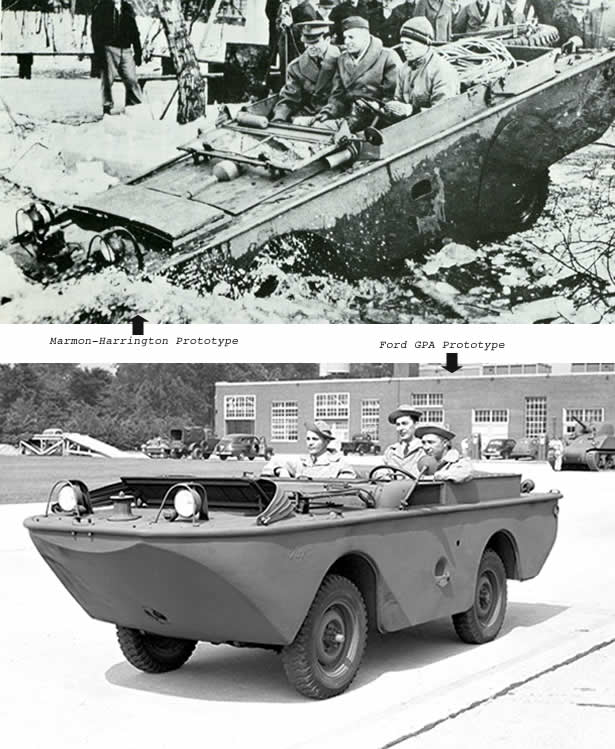
Production of the seeps began in fall of 1942. Out of the 12,774 GPAs produced, 3,520 were sent via Lend-Lease programs to Russia (see photos of Russian Lend-Lease Museum), which experienced success with them. The remainder of the amphibious vehicles were utilized by American forces with varying results. Geography played a critical role in the perception of their capabilities. The Russians were fighting across lands full of swamps and rivers. The ability of the seep to float over calm bodies of water proved an excellent military advantage to such a degree they developed their own version after the war: Gaz 46.
Conversely, American forces most often wanted the amphibious craft for landing on beaches, which meant traveling through rough oceans and seas before landing. Because so little of the seep extended above the surface, the seep could (and did) easily capsize in rough water. Moreover, the seep was incapable of carrying large amounts of equipment or soldiers. The development of the heartier amphibious six-wheeled DUKW sealed the GPAs fate. In the Spring of 1943 Ford was told to halt production of the seep.
Like many other military vehicles, leftover GPAs were sold as surplus. Several would-be adventurers thought, with a few modifications, the vehicles could prove useful for traveling long distances. It appears only a handful of people undertook the difficult challenge of modifying the GPA to overcome the capsizing and space issues and utilize them for their trips. Briefly, here are their stories.
1. HALF-SAFE: 1948-1958. Probably the most famous of the GPA explorers is Australian Ben Carlin, who circumvented the world in his modified seep named 'Half-Safe'. He's regarded as the first to attempt long-term travel in a seep. He and Half-Safe traveled 50,000 miles over a period of ten years. His exploits filled three books, each book covering his voyage in different ways. You can see Half-Safe in action in this video: https://www.youtube.com/watch?v=z-Gqi-RlbO0
A) HALF-SAFE: Across the Atlantic by Jeep (1955) by Ben Carlin:
Ben's book describes the difficulties Ben and his wife Elinore faced during the first leg of their adventure as they attempted to cross the Atlantic. They began their journey by leaving Montreal, Canada, in 1948. Unfortunately, they failed in that attempt. Three subsequent efforts failed as well. Between 1948 and 1950 the couple learned just how unprepared the seep was for ocean travel. Finally, in the summer of 1950, with many repairs and modifications, they began their successful journey, landing in the Azores in August of 1950 and, eventually, arriving in London, England, in late 1951. The November 20, 1950, issue of Life magazine covered some of their journey. The photo below demonstrates the types of modifications necessary to cross the Atlantic. The three biggest issues, and most obvious alterations to Half-Safe, included the need to keep water out of the vehicle (thus the added cabin), the want of extra gas (note the large portable tank under the seep) and the importance of better steering (hence the addition of the detachable keel on the front).
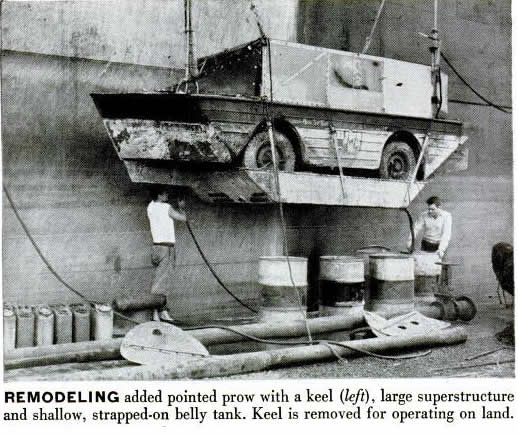
B) THE OTHER HALF OF HALF-SAFE: Around the World by Amphibious Jeep from Montreal Across the Atlantic, Europe, Asia, Australia, Japan and the Pacific to Canada and Back to Montreal (1989) available from Ben Carlin's alma mater the Guildford Grammar School:
Having reached Britain, the Carlin's decided that Half-Safe had to be completely rebuilt to continue the journey. So, between 1952 and 1954 they raised money for the remainder of their journey and worked on their vehicle. In May of 1954 Ben and Elinore began the second leg of their journey southeast from Britain, through Europe, into the Middle East and eventually to Calcutta India. At that point, Elinore decided she was done exploring (and at least one report says they divorced in Dec of 1955). From Calcutta, Ben navigated over the Burma Road, wound through Southeast Asia, then turned north until he reached Japan in the summer of 1956. At that point, Half-Safe needed more repairs.
 C)
Once a Fool!: From Japan to Alaska by Amphibious Jeep!
C)
Once a Fool!: From Japan to Alaska by Amphibious Jeep!
Boye Lafayette De Mente:
In 1957 Ben and American writer Boye Lafayete De Mente (pictured to the right) left Japan for the final leg of the trip. They traveled to the Aleutians and onto Anchorage. At that point De Mente decided he'd had enough adventure and flew home to Phoenix, Arizona.
An entry in Wikipedia provides insights and links to news articles about the remainder of Ben's adventure. From Anchorage, Ben continued onward, driving south through Cananda to San Francisco, where he met up with Elinore, before turning northeast toward Montreal. Ben Carlin completed his circumvention May 13, 1958.
Ben Carlin died in 1981. HALF-SAFE remained in the United States until it was shipped to Australia. It is housed in a special glass structure at Ben's alma mater, the Guildford Grammar School in Western Australia.
2. LA TORTUGA: 1954-1955. Helen & Frank Schreider
20,000 Miles South: A Pan American Aventure in a Seagoing Jeep From the Arctic
(A nearly identical version is published under the name La Tortuga).
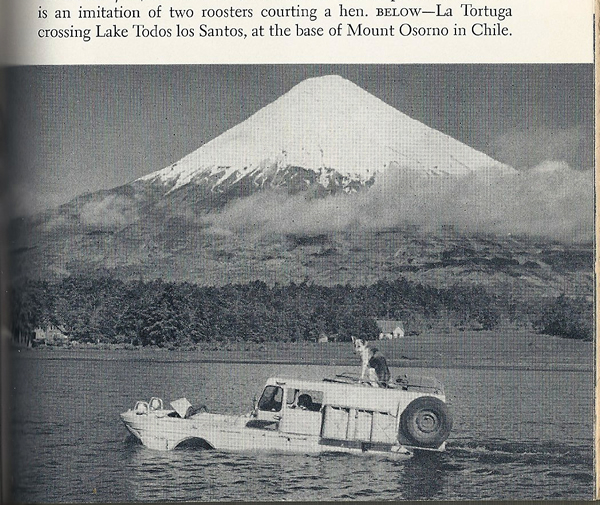
Helen and Frank Schreider began their book by describing their first failed attempt to travel through Panama in a Willys Wagon. This led to their decision to try a Pan-American adventure in a Ford GPA, which they named La Tortuga (The Turtle). Aware of Ben Carlin's adventure, Frank modified La Tortuga to handle rough water and extended living conditions.
In 1954, Frank and Helen, along with their dog Dinah, began their journey in Alaska at the Arctic Circle. Using an unidentified vehicle they drove from the Arctic Circle to California, where they'd stored a Ford GPA they'd purchased several years earlier. The North American leg of their trip was so unremarkable they cover that entire journey in only two pages of the book. The real adventure began with the assembly and launch of the GPA and their trip through Central America. At one point they had to drive down a railroad track, but were forced to give up the effort due to the damage inflicted on La Tortuga. At another point they entered the country of Colombia by water, only to be told when they attempted to leave the country that they didn’t get the proper entry stamp (because they'd entered via the water).
Despite their obstacles, eighteen months and 20,000 miles later they reached Tierra Del Fuego at the sourthern tip of Argentina. They carefully recorded their entire journey. Not only did they publish a book, but they also filmed a documentary in color that was part of a lecture tour. In addition, their adventure was serialized in the Saturday Evening Post:
- January 12, 1957, We Made the “Impossible” Tour, Part One: How We Motored Through the Jungle
- January 19, 1957, We Made the “Impossible” Tour: Part Two: How We Went to Sea in a Jeep
- January 26, 1957, We Made the "Impossible" Tour, Part Three: Island-Hopping the Spanish Main
- February 2, 1957, We Made the “Impossible” Tour: Part Four: Trigger-Happy Territory
- February 9, 1957, We Made the "Impossible" Tour: Conclusion:The Land of Fire - three agonizing miles of travel in southern Argentina.
Once they completed their Pan-American journey, they shipped La Tortuga back to California. In 2006 the Ford GPA was re-discovered, sold and shipped to a new owner in Norway. La Tortuga is for sale.
3. AMPHIB: 1957-1958. Lionel Forge. There's no book, but Colin Stevens maintains a website with information. Below is a photo of Lionel's GPA modifications in progress. He's mounting a 1949 Dodge Station Wagon roof to the top of the seep.
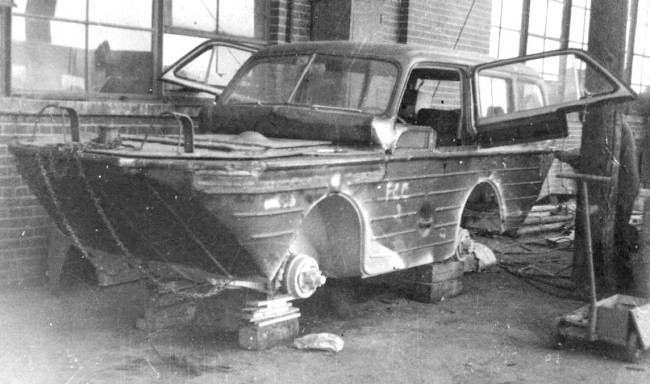
Canadian Lionel Forge's story still exists thanks to Colin Stevens and his website. According to Colin, Lionel owned a Ford GPA named 'Amphib'. After reading about Ben Carlin's adventures, Lionel decided he would modify 'Amphib' for an extended adventure. Lionel planned to travel through Central and South America, ship the GPA to Africa (he didn't want to sail across like Carlin), and then drive north to Europe.
According to Colin, Lionel made it to Central America, but then discovered the cargo ship he planned to use to travel to Africa was no longer in service. So, he shipped ‘Amphib’ to a friend’s house in Florida and continued some additional traveling. Eventually Lionel brought Amphib back to Canada, where it sat for at least 11 years on blocks (most likely much more) until Lionel’s death in 2001. Lionel’s family later sold the GPA to Colin, who photographed it extensively, recording all kinds of information about it. Colin then sold it in 2004 to an American collector.
Learn more at Colin’s website. Colin also wrote a two-part article in the Candian Heritage Military Magazine Convoy Magazine in 2002 about the entire adventure, which he pieced together from Lionel’s images, passports and other information.
4. LA TORTUGA II: 1960. Helen & Frank Schreider.
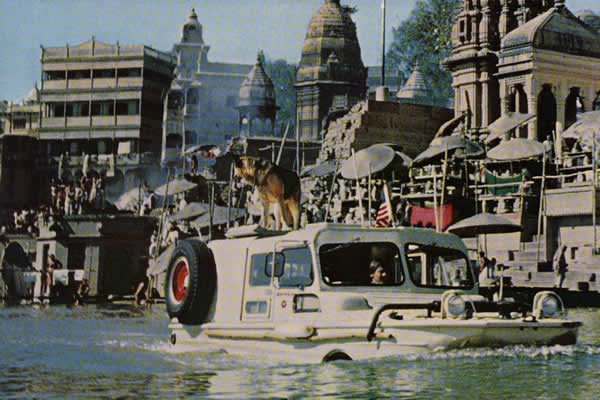
In the late 1950s, following a successful 1954-1955 Pan-American trip and lecture series, Helen and Frank Schreider began working with National Geographic. They apparently agreed to a two-part exploration plan. First, the couple would travel along India's Ganges River Plain in a Ford GPA from the mouth of the river to its source and report on their experience. Second, they'd head toward Indonesia for a much longer adventure, which they described in the Drums of Tonkin.
The 1954-1955 drive through Central and South America beat up their original Ford GPA, 'La Tortuga', badly. While they shipped La Tortuga back to California after reaching Tiera Del Fuego, it appears the damage was bad enough that they didn't attempt to use that GPA to travel again. So, for their new adventure to India and Indonesia they modified a second GPA, calling it 'La Tortuga II'. One way to tell the difference between I and II is the location of the exhaust pipe. On I it is farther behind the lights than it is on II. One reason for this is that the cabin extends farther forward on II than on I. Here are comparison photos:
Tortuga I - Pan American Trip Frank and Helen Schreider. Note the damage to the sides:
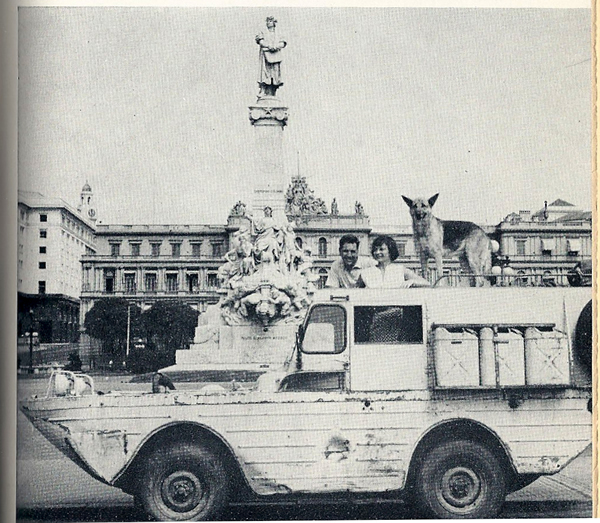
Tortuga II in India. Note how the cabin reaches farther forward and the muffler on the bow is more closely mounted to the lights. The fate of this GPA is unknown at this time:
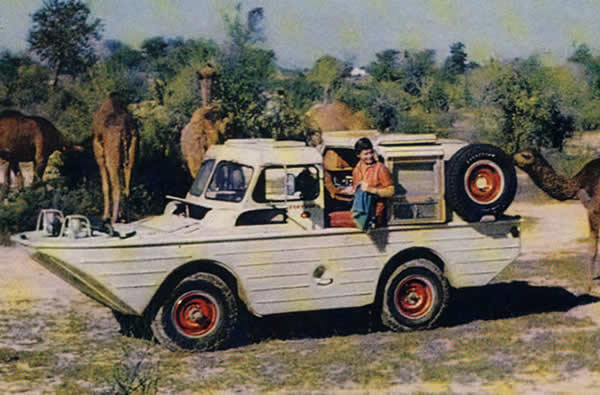
Their five month 1960 India adventure from the mouth of the Ganges to its source filled forty-two pages of the October, 1960, issue of National Geographic. There's a definite shift from reporting about their seep and their obstacles, as they did in their first book, to an emphasis on the people and cultures they encountered. In other words, they focused less on adventure and more on anthropology, geography and biology. Still, they did capture a few photos of La Tortuga II exploring the waters and plains of the region.
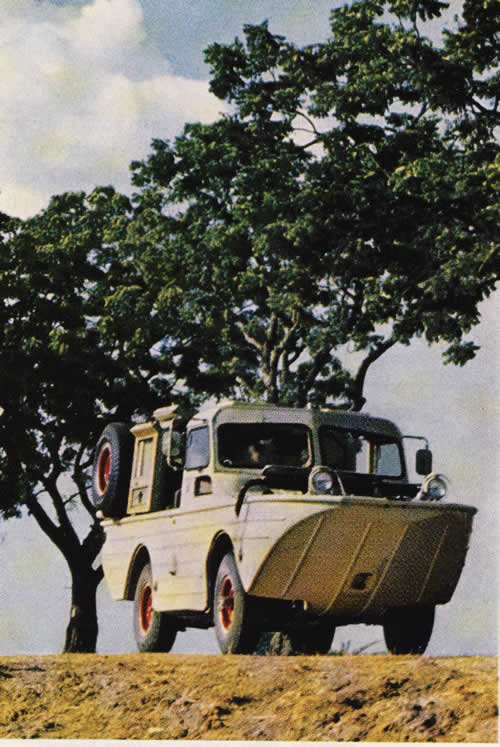
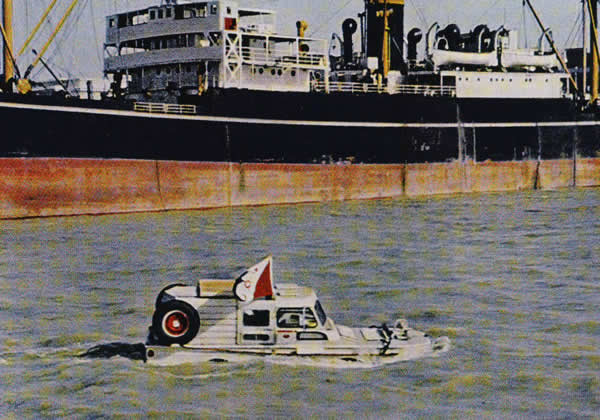
5. TORTUGA II: 1960 Frank and Helen Schreider's trip through Indonesia.
The Drums of Tonkin An Adventure in Indonesia
.
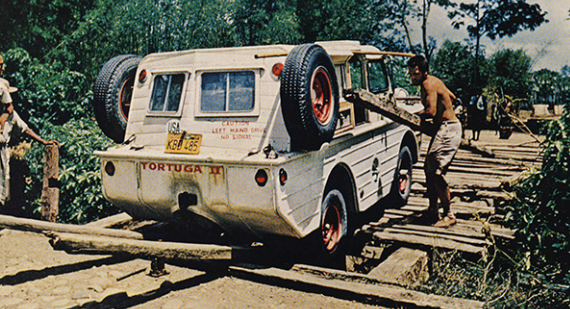
On the heels of their India trip, the Schrieders, again with National Geographic support, tackled the breadth of Indonesia, a 17,000 island archipelago, going to places and completing a trip that few, if anyone, has replicated. Their 4,000 mile trip lasted a year. Their ability to shuttle between islands and over land took them to places no vehicles had gone.
Their first report filled 48 pages of the May, 1961, issue of National Geographic. During that trip they explored some of the Greater Sunda Islands of Indonesia, including Bali, Sumatra, Java, and a few others. During the second half of their trip, reported in the August, 1962, issue of National Geographic, they covered what are known as the Lesser Sunda Islands.
Following the trip, they assembled their experience into a book called the Drums of Tonkin: An Adventure In Indonesia. Based on the information in the book, La Tortuga II was shipped back to California, but what happened to it after that is unclear.
After their Indonesion adventure, Frank and Helen appear to have abandoned the notion of traveling in a seep. However, they continued to travel. Hired by National Geographic they authored a book in 1970 called Exploring the Amazon. They photographed places around the world. (View some of Helen's beautiful travel photographs here). Frank Schreider died in 1994.
Out of the original 12,774 built, approximately 200 still exist. Gavin Walker keeps tabs on the existing GPAs by maintaining a database of serial numbers. If anyone knows of others who've dared to explore using a Ford GPA, please let me know d[@]ewillys.com.
Links:
- Seep History @ m201: http://www.m201.com/GPA.htm
- GPA Articles at Hemmings: http://blog.hemmings.com/index.php/tag/ford-gpa/
- Ford GPA Prototype @ the Library of Congress: http://www.loc.gov/pictures/resource/fsa.8b06509/
- GPA @ the Jeep Collection: http://www.jeepcollection.com/portfolio/1942-ford-gpa/
- Books: http://www.amphibiousvehicle.net/BOOKS-novel.html
- GPA production information from G503: http://g503.com/forums/viewtopic.php?f=22&t=185466
- Gavin Walker's Ford GPA List: http://willysma.com/gpa_serial/gpa_list.php?id=1&type=GPA&sortby=serialNo
- Pan-American Adventure @ eWillyshttp://www.ewillys.com/2014/01/01/20000-miles-south-by-helen-and-frank-schreider/
- Ganges Plain Adventure @ eWillyshttp://www.ewillys.com/2014/02/23/a-1960-trip-up-the-ganges-river-in-a-ford-gpa/
- Indonesian Adventure @ eWillys http://www.ewillys.com/2014/02/08/drums-of-tonkin-a-book-by-helen-and-frank-schreider/
Half Safe:
- Overview of trip: http://en.wikipedia.org/wiki/Ben_Carlin
- Photos: http://members.iinet.net.au/~daveb/halfsafe/halfsafe.html
- Children's version: http://www.ewillys.com/2014/01/11/1973-issue-of-world-of-wonder-on-ebay/
- Article @ Hemmings: http://blog.hemmings.com/index.php/2011/03/02/ambitious-amphibious-ben-carlins-round-the-world-trek-in-a-ford-gpa/
- Video: http://www.britishpathe.com/video/the-half-safe
- Video: http://www.youtube.com/watch?v=z-Gqi-RlbO0
 Author David Eilers grew up in the Seattle area among jeeps and jeepers, camping and exploring the Pacific Northwest. He's operated eWillys, a vintage jeep website, for more than six years. He's won awards for his jeep community efforts and toured the nation giving presentations. Learn more about him and read his latest book, The Amber Panels of Konigsberg, which includes a fictional Ford GPA called 'JOLO'.
Author David Eilers grew up in the Seattle area among jeeps and jeepers, camping and exploring the Pacific Northwest. He's operated eWillys, a vintage jeep website, for more than six years. He's won awards for his jeep community efforts and toured the nation giving presentations. Learn more about him and read his latest book, The Amber Panels of Konigsberg, which includes a fictional Ford GPA called 'JOLO'.